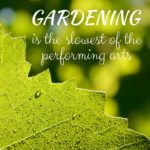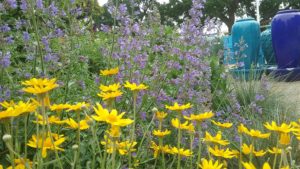“Gardening is the Slowest of the Performing Arts”
 Garden Historian and writer Mac Griswold’s quote is a favorite at Alden Lane, and as we roll into 2021 it got us reflecting on time as an element of garden design. With Nature being the major component of our design palette, change is constant. From a mindset of embracing this change and evolution in our landscapes, we can watch first-hand how plants grow to full size and, yes, sometimes die. Watch as over the course of a year wind ripples through the foliage; sun angles highlight fall leaves and grass plumes; blazing summer sun sends us into the shade; all manner of wildlife finds a reason to show up; rain pops California poppies out of the ground; frost blankets everything with shimmering crystals. That knee-high Camellia you planted a while back – it’s now 8′ tall and its blooms are in their full glory.
Garden Historian and writer Mac Griswold’s quote is a favorite at Alden Lane, and as we roll into 2021 it got us reflecting on time as an element of garden design. With Nature being the major component of our design palette, change is constant. From a mindset of embracing this change and evolution in our landscapes, we can watch first-hand how plants grow to full size and, yes, sometimes die. Watch as over the course of a year wind ripples through the foliage; sun angles highlight fall leaves and grass plumes; blazing summer sun sends us into the shade; all manner of wildlife finds a reason to show up; rain pops California poppies out of the ground; frost blankets everything with shimmering crystals. That knee-high Camellia you planted a while back – it’s now 8′ tall and its blooms are in their full glory.
Because in the natural world change and evolution are givens, take the long view in planning and design. Here are some ideas to think about as you invest in your personal landscape:
o Start with permanent plantings that will form the framework of your design for years to come. What do you wish you had planted 5 years ago? Think about long lived trees and shrubs.
o Plant food for your family. This is fruit tree season, when the selection is at its largest and planting conditions are favorable. Prepare soil now for spring vegetable planting season.
 o Plant for wildlife. Think about multiple layers of foliage for shelter and a fountain or birdbath for a water source. A year-round succession of blooming plants will produce the nectar and pollen “garden buffets” for our pollinator friends the bees, butterflies and hummingbirds.
o Plant for wildlife. Think about multiple layers of foliage for shelter and a fountain or birdbath for a water source. A year-round succession of blooming plants will produce the nectar and pollen “garden buffets” for our pollinator friends the bees, butterflies and hummingbirds.
o Plant diversity. By planting a variety of different plants suited to all of your yard’s micro-climates, we strengthen the ecosystem and
minimize pest and disease problems.
o Plant small. Trees from a No.15 container can establish quickly. Plant shrubs from No. 1 or No. 5 containers, and perennials from 4″ or No. 1 containers. Remember to space out your plants to allow for their mature size. It’s ok if the design looks a little sparse at first.
o Edit as needed, pull out anything that hasn’t done well, is too crowded, or that you simply don’t like. Refresh with new plantings. Enjoy the growth and change of your garden’s performance for years to come.
Follow us in Social Media